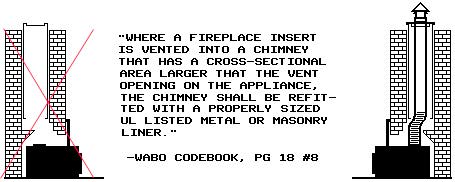
The Chimney Sweep Online Fireplace, Woodstove, Gas Stove and Barbecue Shop

The Chimney Sweep Online Fireplace, Woodstove, Gas Stove and Barbecue Shop

CODE VIOLATION: Flue oversizing is a common code violation in fireplace insert installations, because the flue size needed to vent the extreme volume of exhaust created by an open fire is way larger than the 6" or 8" flue collars on today's high-efficiency wood inserts. As exhaust from the fire passes through the flue collar of the insert, it must expand to fill the firebox above the insert, then the smoke shelf area, and finally the oversize flue. This slows the rate of draft and allows the wood exhaust to cool in the flue, leading to draft problems and the kind of excessive creosote formation that leads to chimney fires. Oversize gas insert flues need liners too. Gas exhaust is relatively cool and very wet, so it travels up the chimney flue quite slowly. When it is forced to expand to fill an oversized chimney, its flow rate can be reduced to the point where the poisonous exhaust gases seek another outlet - into the room. | CODE REQUIREMENT: A UL listed, stainless steel flue liner, the same diameter as the exhaust opening on the insert, is lowered down the chimney flue and connected directly to the insert's flue collar. A sealer plate at the top of the chimney creates dead-air insulation, keeping flue gases warmer and improving updraft, which reduces creosote formation. Ceramic blanket insulation may be added if warmer flue temperatures are needed. A top clamp, storm collar and rain cap complete the installation at the top. Flexible stainless pipe is most often used for fireplace insert installations, as it is easier to snake through the damper area and any offsets in the chimney above. For gas appliances, UL listed aluminum alloy pipe is used in place of stainless steel, due to its resistance to both water damage and nitric acid corrosion. A properly sized liner is the first step to insure against gas exhaust backdrafting. |
THE BOTTOM LINE: NEVER VENT INTO AN OVERSIZE CHIMNEY! For more info about installing a stainless liner, click here. Note: Each Code Authority chooses the standards that regulate appliance and chimney installation and usage in their jurisdiction, and may modify
code specs as desired. The above-referenced specification is from the Washington Association of Building Officials Woodstove Installation Code
Book, and may not reflect the code requirements in your area. Contact your Code Authority for local regulations.
| |